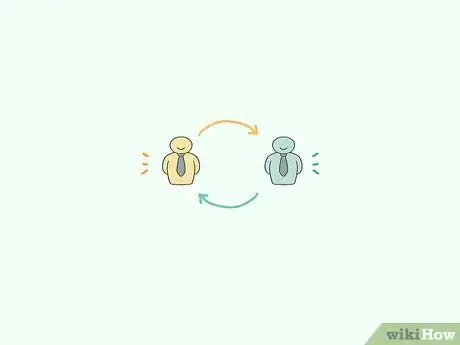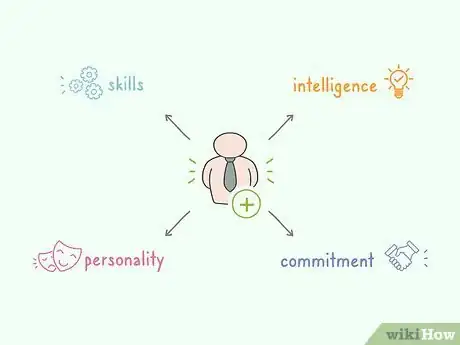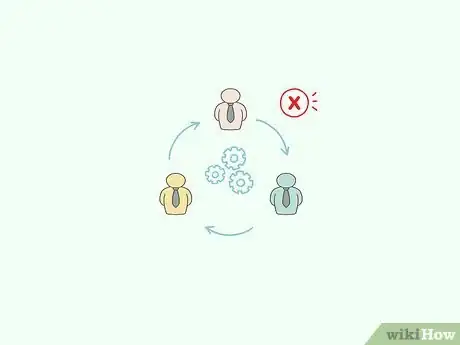This article was co-authored by Elizabeth Douglas. Elizabeth Douglas is the CEO of wikiHow. Elizabeth has over 15 years of experience working and managing teams in the tech industry. She has held roles in multiple areas, including computer engineering, user experience, and product management. She received her BS in Computer Science and her Master of Business Administration (MBA) from Stanford University.
There are 8 references cited in this article, which can be found at the bottom of the page.
wikiHow marks an article as reader-approved once it receives enough positive feedback. In this case, 100% of readers who voted found the article helpful, earning it our reader-approved status.
This article has been viewed 332,059 times.
In the world of business, the high rate of employee turnover can be a significant problem. Economic research suggests that for some industries it can cost up to one-fifth of an employee's annual salary to find, train, and hire a suitable replacement.[1] If turnover rates are too high, this represents a significant sunk cost for the company that can't be recouped. Luckily, by improving the environment at work, practicing smart hiring strategies, and ensuring that your company is optimally-organized, it's possible to keep turnover at a healthy minimum.
Steps
Improving the Work Environment
-
1Pay more (or offer a path to a raise). In the free marketplace, cash is king. If you're willing to pay your employees more than a competitor would, they'll be less likely to leave for other work. An added benefit of increasing your employees' pay is that it allows you to ask more of them — well-paid employees have an incentive to work harder and commit themselves to their job, while employees who are making relatively little won't usually have the same level of dedication or loyalty.
- If you don't have the cash to pay your employees more than the competition, be creative. For instance, offering company stock options or equity plans is a relatively low-cost way to increase the long-term earning potential of your employees. As an added benefit, these sorts of options give employees a real financial stake in the company — if they work hard and help the company do well, their stock value will go up and they'll make money.
-
2Offer potential for advancement. Employees like to feel like their hard work is being rewarded. As a manager or business owner, part of making sure your employees feel this way is compensating them fairly for their work, but another part is giving them the opportunity to achieve the non-tangible benefits of recognition and advancement. Reward exceptionally smart, resourceful, and hard-working employees by gradually increasing their responsibility and giving them more important titles. An employee who's advanced from an entry-level position to a manager role is much more likely to be loyal to your company than one who's done the same job for years in spite of her hard work.
- It’s not enough to simply ‘’offer’’ the potential for advancement — it’s also important to make sure that employees understand how they can advance in your business. If you're having a hard time communicating this to your employees, try inviting a career counselor into the workplace once or twice a year to discuss this with them.
- Try to promote from within your workforce, rather than recruiting outsiders into management roles. While this may sometimes be unavoidable, hiring an outsider to fill a management vacancy when there are qualified employees with years of experience who could conceivably do the job can give the impression that you don't care about your employees' accomplishments.
Advertisement -
3Rebalance the work load. If an employee's work is stressful, monotonous, or extremely difficult, different jobs with comparatively easy work loads will start to look very attractive. Never work your employees to the point of exhaustion — this is one of the easiest ways to cause your employees to start looking for other work en masse. In addition, it's also often financially inefficient: employees with very long or stressful jobs will require significantly higher pay levels to retain than employees with ordinary duties and hours.
- There is a wealth of evidence to suggest that working your employees extra-hard can actually cause their net productivity to plummet — even to below the level of productivity from a normal 40-hour week in some cases! Some research has found, for instance, that excessively long hours can cause employees to take longer to perform the same tasks as they normally would, deal poorly with problems requiring critical thinking or creativity, make more mistakes, and waste time engaging in recreational or personal activities at work.[2]
-
4Offer competitive benefits. Increasingly, people looking for work don't just consider the salary being offered by a potential employer, but also the benefits provided. By offering affordable benefits like health insurance, dental insurance, 401K plans, and, as mentioned above, stock options, you can make a job at your company more appealing than one at a competitor's, decreasing employee turnover. Reviewing your benefits package is something your company should do regularly — at least once a year.
- Be aware of the benefits your biggest competitors are offering their employees. If they start offering more generous benefits than you, they may be able to steal some of your best employees, so don’t let them get the jump on you!
- In the U.S., millions of employees depend on an employer's health care plan to make their medical care affordable. Offering a good employee health insurance plan can make a job with your company especially attractive, decreasing turnover and making it easier to hire. In addition, ensuring your employees have decent health coverage can be a wise investment in the long run — healthy employees are productive employees.
-
5Encourage friendly employee relationships. To long-time employees, coworkers and bosses can function like something of a family, providing friendly relationships, conversation, and sometimes even emotional intimacy. Don't let your employees' jobs become a source of a source of boredom or dread for them. Instead, try to foster a warm, open environment at work. Employees should be comfortable talking, joking, and making outside-of-work plans with each other as long as it doesn't interfere with their work.
- If your employees seem "cold", standoffish, or emotionally distant, try sponsoring a fun workplace outing to lighten the mood. Going out for drinks, catching a movie, or playing sports after work can be a great way to bond with your employees and allow them to bond with each other, even if you can only do so once or twice a month.
-
6Trust your employees with responsibility. People tend to work hardest (and smartest) when they think their jobs matter.[3] Though this is often forgotten by even the best managers, it's surprisingly intuitive. Consider this: who is likely to work harder — a mail room clerk with little responsibility or a heart surgeon with responsibility over other peoples' lives? Try to make an effort to give the employees with even the most minor jobs some sense of importance or responsibility. If they understand exactly how their work is essential to the business's success, they'll have added motivation to succeed in their jobs.
- Ironically, giving people added duties that increase their responsibility can actually make their jobs more attractive to them. However, if you do this, be open to the possibility of promotion or a raise in the future — employees don't want to deal with increased responsibilities without ever being rewarded for their work.
Improving HR Practices
-
1Hire more selectively. Most business experts agree that one of the very best ways to keep your employee turnover rate low is to ensure that the people you hire are right for the job in the first place.[4] Picking employees that have exactly the right qualifications and personality for the job you're hiring for ensures that they'll learn quicker, perform better, and, most importantly, feel happier in their new role. Below are just a few of the most important types of criteria you’ll want to carefully review and vet for each candidate before hiring:
- Skills — does this person have what it takes to increase your business’s value?
- Intelligence — does this person have the smarts or creativity necessary to perform under pressure?
- Personality — does this person fit your company culture?
- Commitment — does this person’s life make it possible to offer the sort of commitment you’re looking for?
-
2Conduct regular employee reviews. If your business is suffering from high employee turnover, one of the best reasons to find out why is simply to ask your employees. Having regular review sessions in which you (or another qualified person) meet with each employee and talk about what they like and dislike about their job is a great way to make sure the employees feel valued and see their concerns being acknowledged. If you don't feel that you're up to this task as a manager, don't worry! For a fee, a third-party HR agency can handle the process for you.
- As an added benefit, these review sessions can also give you great ideas. For instance, if one employee who's sick of sitting at her desk all day has a great idea for putting a standing desk in the break room, doing this might make her significantly more happy in her job for a relatively small one-time cost.
- Your reviews should involve a healthy back-and-forth of information sharing. Don’t use reviews merely as an opportunity to critique your employees — they should also be an opportunity for your employees to critique you. Be willing to "meet your employees in the middle" as long as their demands are reasonable and their intentions are good.
-
3Conduct exit interviews. Even friendly, open companies with great work environments occasionally have to let people go. When your business has to do this, take the opportunity to conduct a thorough exit interview with the employee being dismissed before he's gone for good. Some business experts have found that employees are more willing to be candid at exit interviews, though others have found that many employees will be less critical in hopes of getting a good recommendation.[5] In any case, an exit interview is your last chance to learn what went wrong with an unhappy or unproductive employee, so take advantage of it. Below are just a few of the sorts of questions you'll want to consider asking:
- "What was your favorite/least favorite part of the job?"
- "Was there anything that made it difficult for you to perform your duties properly?"
- "In the future, how could we avoid the types of problems you faced in your job?"
- "Is there anything you wish the company had done that it didn't do?"
-
4Regularly review and assess employee concerns. Merely asking your employees what makes them unhappy isn't enough — to keep them feeling valued, you'll need to make a reasonable effort to address their concerns and, most important of all, show them that you're making this effort. If your employees can see that their comments and suggestions are being taken to heart, they'll feel like they're being listened to and that their opinions matter in the grand scheme of your business, which can make even a low-level employee feel happier in his job.
- For example, if you notice that many of your employees are complaining about the fact that they feel disconnected from the rest of the company — in other words, that they can't see how their individual jobs affect the success of the business as a whole — you may want to consider having monthly team-building events where employees from one part of the company work with employees from another part for the day. This can help give your employees an "bird's eye" view of the company's inner workings.
Organizing for Employee Retention
-
1Retrain managers with high turnover. Sometimes, high turnover may not be a problem for the entire company, but instead only for certain divisions or departments. In this case, the root cause may be something the heads of this department have no control over (for instance, pay levels or deadline schedules set by upper management), but it may also be the management style of individual supervisors that is causing the problem. If this is the case, strongly consider re-training the problematic managers before firing them and searching for replacements. The one-time cost of a short management course is usually much less than the time and money wasted replacing an employee in a high-paying, highly-skilled management position.
- Some business experts argue that an employee's manager can have a greater effect on his overall job satisfaction than even his wages, hours, or benefits.[6] In any case, effective managers are vital to a company's success, so making an investment in the ones you have can substantially reduce turnover.
-
2Consider alternate roles for unhappy employees. Sometimes, otherwise productive employees just aren't a great "fit" for the job they've been given. While they may work hard, their personality or skill set may keep them reaching the full potential of their role. In these cases, try to avoid dismissing the employee until you've considered other roles or duties for them. Don't fire an employee who's well-suited for some other important role in your company — if you do, you'll be forcing your company to undergo the costs of finding and training a replacement without getting your money's worth out of a perfectly competent employee.
- Be aware of how you present a role change to an employee. To avoid hurt feelings, for instance, don't tell the employee that she's performing poorly and that the company thinks she'd do better in a different role. Instead, focus on the positive — tell her that you've found something more important for her to do! Being aware of the language you use in this situation can make the difference between your employee thinking of her new role as a promotion or a demotion.
-
3Avoid constant reorganization. In many cases, finding new roles for old employees can be something that leads to increased productivity and satisfaction. However, large-scale corporate reorganizations are usually something that employees fear, and with good reason. Most company-wide reorganization efforts result in some layoffs (sometimes many).[7] Frequent reorganizations can lead to a culture of fear and uncertainty in your workforce and encourage them to seek other, more stable jobs. To avoid this unfortunate situation, try to avoid frequently re-structuring your workforce. Slow, gradual changes are almost always better-received than sudden, wide-scale ones.
- If you do have to have a major company-wide reorganization, minimize the morale damage by clearly communicating to your remaining employees why the reorganization had to happen and explaining that their jobs are not in danger in any way. Though there will probably still be some lingering unease, good communication can help keep the damage as minimal as possible.
-
4Don’t be afraid to fire bad employees. In the words of the old cliché, "Sometimes, to save the hand, you have to lose the finger." Getting rid of exceptionally problematic employees is a must for any business looking to keep turnover at a minimum. Employees that perform poorly, have a negative attitude, or are grossly incompetent can hold your company back. Worse still, they can contribute to other employees developing negative attitudes towards work by sharing their negative views or demonstrating (through example) that bad work can go unpunished. Don't be afraid to get rid of employees with bad attitudes — if you do this, you'll usually have to fire less people in the long run.
- Don't ignore workplace negativity! Research shows that more people in a workplace vocalizing negative thoughts, the more likely that otherwise happy and productive employees are to adopt them.
Expert Q&A
-
QuestionIs employee turnover good or bad?
 Elizabeth DouglasElizabeth Douglas is the CEO of wikiHow. Elizabeth has over 15 years of experience working and managing teams in the tech industry. She has held roles in multiple areas, including computer engineering, user experience, and product management. She received her BS in Computer Science and her Master of Business Administration (MBA) from Stanford University.
Elizabeth DouglasElizabeth Douglas is the CEO of wikiHow. Elizabeth has over 15 years of experience working and managing teams in the tech industry. She has held roles in multiple areas, including computer engineering, user experience, and product management. She received her BS in Computer Science and her Master of Business Administration (MBA) from Stanford University.
CEO of wikiHow It can be a bad thing if you're losing good employees or too many employees. Of course, if you have great employees, you're going to want to keep them. Finding great employees takes time and resources, so it’s better to retain someone awesome than to have to find someone new. With that said, employee turnover is a normal part of life. It’s always going to be a part of running a business.
It can be a bad thing if you're losing good employees or too many employees. Of course, if you have great employees, you're going to want to keep them. Finding great employees takes time and resources, so it’s better to retain someone awesome than to have to find someone new. With that said, employee turnover is a normal part of life. It’s always going to be a part of running a business.
Warnings
- While low employee turnover can be beneficial in some respects, a near-zero employee turnover is actually counterproductive. Turnover is good for filtering out stale company standards by bringing in workers with fresh, new ideas.⧼thumbs_response⧽
References
- ↑ http://www.americanprogress.org/issues/labor/report/2012/11/16/44464/there-are-significant-business-costs-to-replacing-employees/
- ↑ http://cs.stanford.edu/people/eroberts/cs201/projects/crunchmode/econ-factors-decreased.html
- ↑ http://www.entrepreneur.com/article/70060
- ↑ http://guides.wsj.com/management/recruiting-hiring-and-firing/how-to-reduce-employee-turnover/
- ↑ http://www.forbes.com/sites/jacquelynsmith/2012/07/31/you-quit-your-job-now-they-demand-an-exit-interview-what-do-you-say/
- ↑ http://www.forbes.com/sites/reneesylvestrewilliams/2012/01/30/why-your-employees-are-leaving/
- ↑ http://www.forbes.com/sites/reneesylvestrewilliams/2012/01/30/why-your-employees-are-leaving/
- Kiersey Testing
- CPP Testing
About This Article
Employee turnover is a regular part of business, but reducing it can save on costs of hiring and training new employees. There are several things that can impact whether or not employees want to stay at their job, including their pay and their potential for advancement. If you don’t already, try to give your employees a path to a raise that involves more responsibility. This will give them an incentive to work harder and help them feel more valued as employees. Having good work relationships is also really important for employee retention, so make sure your employees feel comfortable talking and joking in the office. To break the ice, you could organize a fun employee outing or start a work sports team. If you still feel like you’re employees aren’t happy, try conducting some employee reviews. This will give you a chance to learn what might need to change at your workplace while acknowledging your employees’ concerns. To learn how to retain managers in your business, read more from the wikiHow CEO!







































































